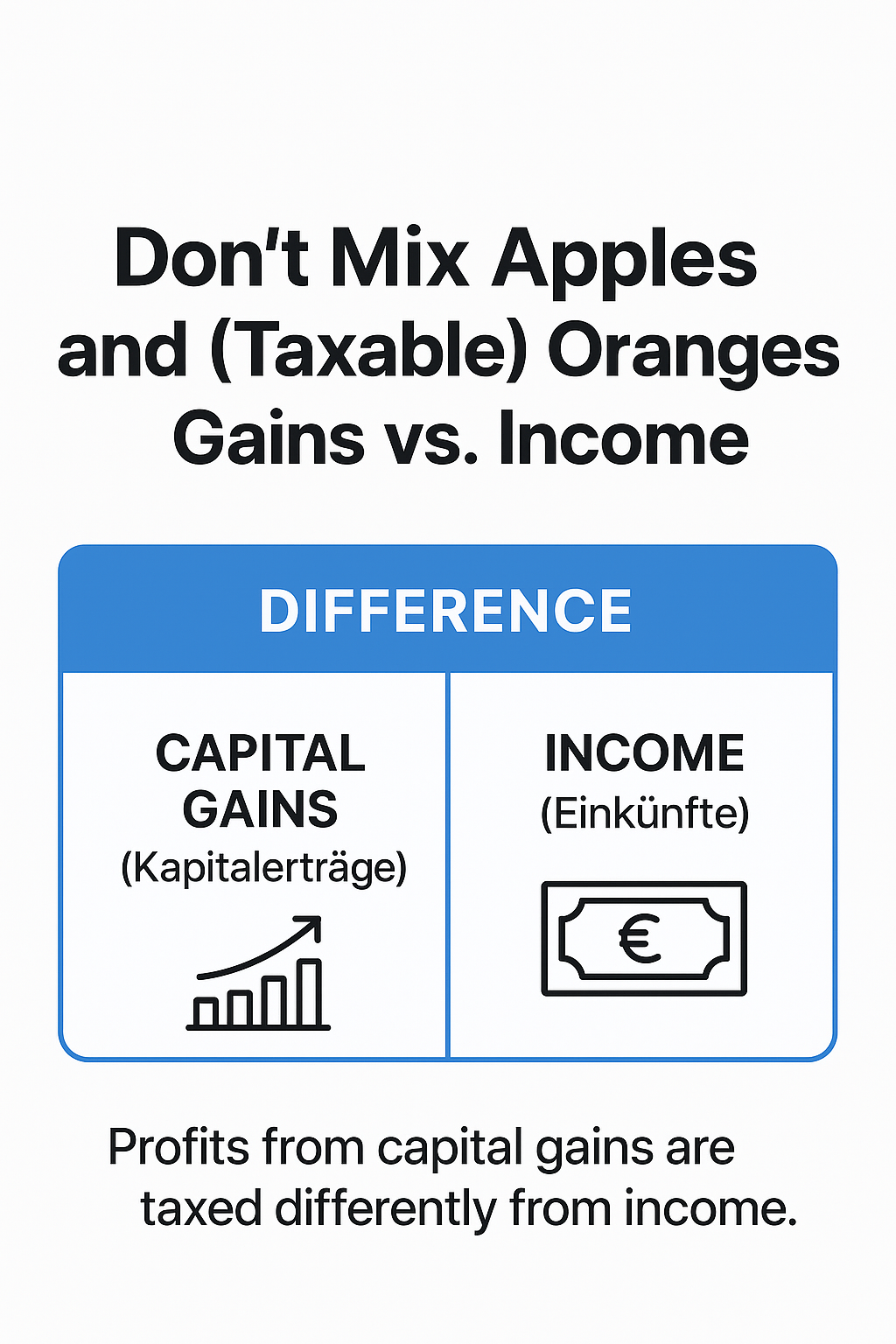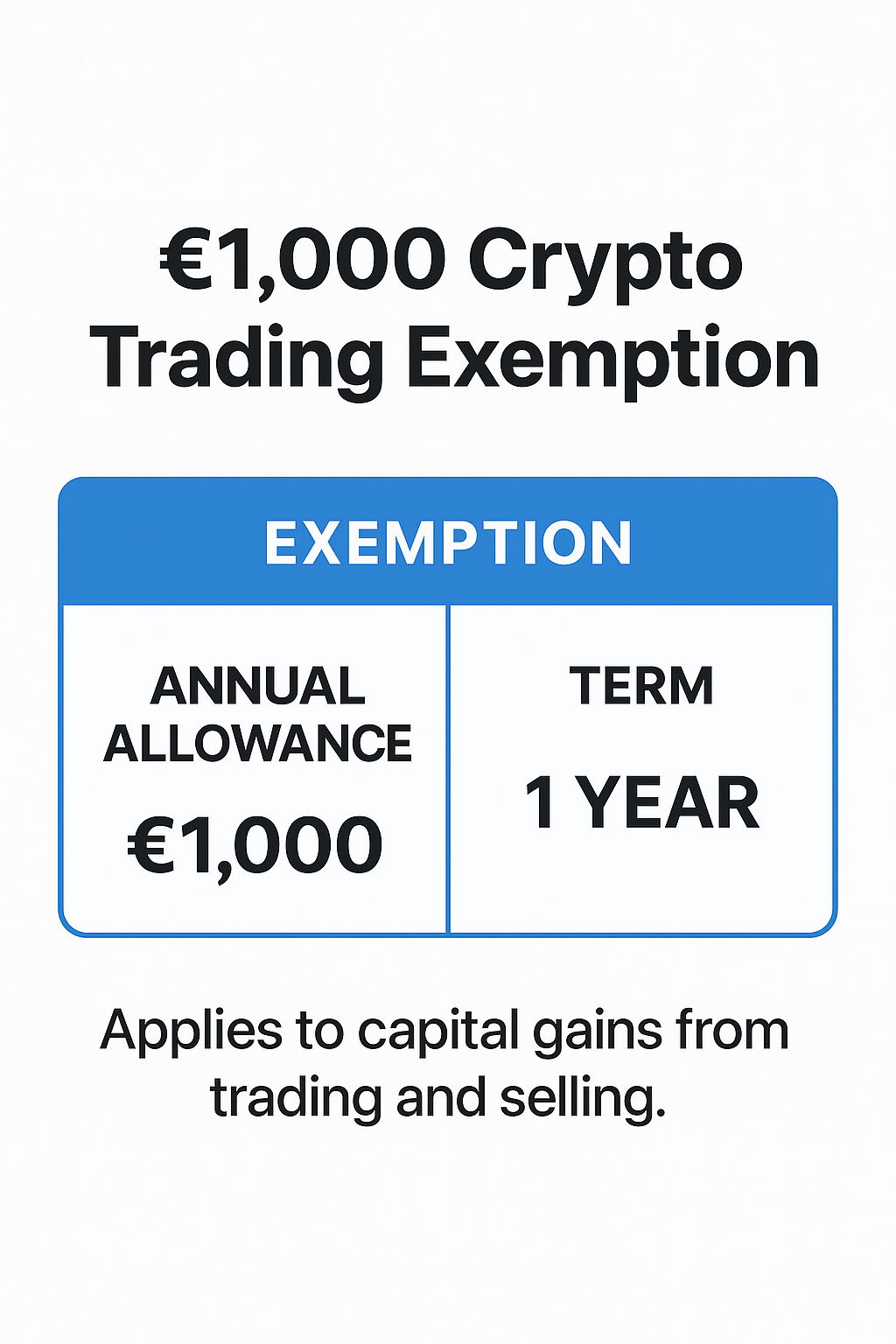The €1,000 Freigrenze: Your Annual Tax Break

The “Freigrenze” (that’s German for tax exemption limit) is like an annual gift from the government since, as long as your total profits from privately selling crypto, gold, or other assets covered by §23 max out at €1,000 per calendar year, they're tax-free. Married couples who file jointly can claim €1,000 per spouse, or a total of €2,000.
The freigrenze isn’t just a crypto-friendly benefit; it's for every privately sold asset. But for crypto traders, it's revolutionary.
The golden formula is:
If your total private sale income is≤ €999 → €0 tax.
If your total income is≥ €1,000 → taxes apply to the entire sum.
If you learn better with examples, here’s an illustrative one:
Let’s assume 2025 is a bountiful year and you make numerous profitable crypto trades.
Let’s kick things up a notch further and assume that you privately sell off some cryptos you’ve held for less than 1 year and net €900. Since you're under the Freigrenze threshold, your tax bill will be €0.
On the other hand, if your gains add up to €1,200, the entire €1,200 gets taxed at a rate that falls between 14% to 45%, depending on your income tax bracket.
The easiest way to remember this is to note that Germany has two separate must-know €1,000 rules.
- The Sparer-Pauschbetrag (€1,000 / €2,000 for married folks) lowers the tax usually tacked on certain capital income like interest, dividends, and many gains from securities.
- Profits from private sales, which are where most of your cryptocurrency sales will fall, are taxable under §23 EstG. The government raised the Freigrenze to €1,000 in 2024. If your yearly private-sale profit is less than €1,000, it’s not taxable. When they're €1,000 or higher, the taxman will expect a check come tax-filing time.
These regulations are individually unique; don’t get them twisted.
The Fine Print: What Counts (and What Doesn't)
Guess what gets most German crypto investors? That’s right: failing to read the fine print, which can be disastrous because while the €1,000 Freigrenze is robust, it has rules that take precedence:
- It's a Freigrenze, not a zero-limit credit card. Exceeding the limit means giving unto Caesar what belongs to him: capital gains tax.
- It's annual and non-transferable. If you only generate gains amounting to €600 in profits one year, the remaining €400 doesn't carry forward to the next tax year.
- The exemption applies to combined profits from private sales. That means it bundles crypto, gold, and other assets.
That implies that for those getting dividends, interest, or income from other securities taxed under §20, the Sparer-Pauschbetrag (€1,000/€2,000) can reduce tax there. But don't confuse this with the §23 Freigrenze for crypto transactions.
Listed below are the monthly own amount (red), additional tax savings (orange), and basic allowance (green), respectively.

Understanding these fine details isn’t just about saving on crypto taxes — it’s about building structured, compliant systems that can handle complexity. That’s exactly what 8lends helps major organizations achieve: clear governance, transparent processes, and the confidence that every number aligns. Whether in corporate reporting or personal finance, structure is what turns uncertainty into control.
Don't Mix Apples and (Taxable) Oranges: Gains vs. Income

Here's a significant distinction that could result in a pounding headache: your €1,000 exemption is for profits generated by private sale under §23 EStG, not income (Einkünfte).
Why's this significant? Because the BZSt considers certain crypto activities as income-generating instead of capital-gains events. Examples include:
- Rewards from staking.
- Lending interest.
- Hard forked coins.
- Airdrops.
Rewards from these events attract taxation as additional income (sonstige Einkünfte, §22) or private-sale proceeds (§23).
Note two important points:
- §22 staking/mining/lending income attracts no tax, but only up to €256 per year; going over that makes all of it taxable.
- Sparer-Pauschbetrag (€1,000/€2,000) is for capital income only (§20) and not for §22 income or most §23 private-sale profits.
Bottom line is your €1,000 cover can protect trading gains and sale profits, but won’t apply to crypto lending, staking, airdrops, and other income-producing activities. Thus, your wallet will thank you if you accurately categorize crypto events.
Most importantly, remember that your €1,000 exemption expires on January 1st. No Exceptions.
Let's be absolutely clear: your €1,000 exemption renews annually on January 1st. It's a use-it-or-lose-it policy with no carryover. At midnight on New Year's Eve, unused allowance disappears into thin air. That makes it a strong, yet frequently overlooked, year-end tax planning strategy opportunity.
Assume your realised private-sale profits for the year amount to just €400. You've got €600 of exemption left about to lapse. That should be your reminder to realise other gains by December 31st. You may be able to sell some properties you've held for under a year, holding up to €600 extra gains tax-free, provided your overall amount is under the €1,000 freigrenze.
Conversely, if you’ve already exceeded your exemption, it might be wise to postpone additional short-term sales until January to push the taxable event into the next year, where a fresh €1,000 exemption awaits. It’s not market timing; it’s tax timing, and it’s the hallmark of a sophisticated investor.
Strategic Trading: How to Maximize Your €1,000 Freigrenze

Here's how intelligent crypto traders use the Freigrenze to reduce taxes:
If you've yet to reach the €1,000 threshold in your overall taxable private-sale gains for the year, you can sell and realize those gains completely tax-free. Tally up your realized private-sale gains annually, preferably in the year’s last quarter. If you're at, say, €800, you still have a €200 wiggle room.
Even if your gains are above €1,000, consider setting them against gains realized by selling other assets privately (not necessarily cryptocurrencies). Acing this timing can lower your net gains to below the threshold.
Your Action Plan: From Theory to Tax-Free Practice
- Tools can expose real-time private-sale profits and ensure you can closely monitor how close you get to the €1,000 threshold.
- Record every transaction, every exchange, and associated costs because accurate data equals correct tax calculation.
- When trade planning, ask yourself: “Am I going to stay under or exceed the €1,000 freigrenze?
- When things get confusing, seek professional tax advice. Complex situations (staking, lending, DeFi) will occasionally fall under other taxation regulations. A Steuerberater is a tax oracle who can ensure you don’t get it wrong.
Conclusion: Trade Smarter, Not Harder
The €1,000 rule converts your role from a passive HODLer into an active strategist. It empowers you to make intelligent choices within a predefined system. It's the government's way of saying, "We'll give you a little space to grow tax-free; use it wisely." So this year, don't leave that Freigrenze to gather dust on a form. Use it, plan with it, and let it be your secret weapon for keeping more of what you earn.
Smart trading is strategy – but sustainable compliance is structure. 8lends equips financial institutions and enterprises with the systems to manage reporting, documentation, and governance seamlessly.
Discover how 8lends can help you turn tax clarity into long-term control.








